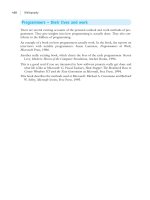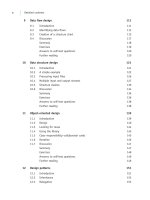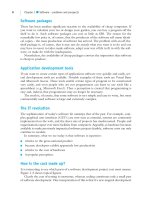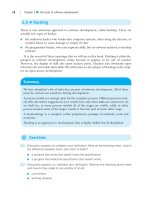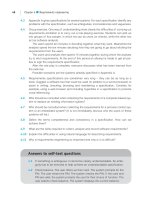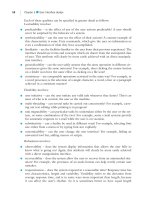Ebook Practical soft tissue pathology - A diagnostic approach: Part 1
Bạn đang xem bản rút gọn của tài liệu. Xem và tải ngay bản đầy đủ của tài liệu tại đây (17.94 MB, 256 trang )
G
R
V
d
e
t
i
n
9
9
U
-
& ns
a
i
s
r
e
p
r
i
h
ta
r
i
.
s
.
ip
v
tahir99 - UnitedVRG
vip.persianss.ir
Pattern Recognition Series
Series editors: Kevin O. Leslie and Mark R. Wick
Practical Breast Pathology
Edited by Kristen A. Atkins and Christina S. Kong
Practical Cytopathology
Edited by Matthew Zarka and Barbara Centeno
Practical Skin Pathology
Written by James W. Patterson
Practical Hepatic Pathology
Edited by Romil Saxena
Practical Pulmonary Pathology, Second Edition
Edited by Kevin O. Leslie and Mark R. Wick
Practical Renal Pathology
Edited by Donna J. Lager and Neil A. Abrahams
Practical Soft Tissue Pathology
Edited by Jason L. Hornick
Practical Surgical Neuropathology
Edited by Arie Perry and Daniel J. Brat
tahir99 - UnitedVRG
vip.persianss.ir
Practical Soft
Tissue Pathology
A Diagnostic Approach
G
R
V
d
e
t
i
n
99
U
-
r
i
.
s
Director of Surgical Pathology
Director, Immunohistochemistry Laboratory
Brigham and Women’s Hospital
Associate Professor of Pathology
Harvard Medical School
Boston, Massachusetts
& ns
a
i
s
r
pe
r
i
h
ta
Jason L. Hornick, MD, PhD
.
p
vi
tahir99 - UnitedVRG
vip.persianss.ir
1600 John F. Kennedy Blvd.
Ste 1800
Philadelphia, PA 19103-2899
PRACTICAL SOFT TISSUE PATHOLOGY: A DIAGNOSTIC APPROACH
ISBN 978-1-4160-5455-9
Copyright © 2013 by Saunders, an imprint of Elsevier Inc.
All rights reserved. No part of this publication may be reproduced or transmitted in any form or by any means,
electronic or mechanical, including photocopy, recording, or any information storage and retrieval system,
without permission in writing from the publisher. Details on how to seek permission, further information
about the Publisher’s permissions policies and our arrangements with organizations such as the Copyright
Clearance Center and the Copyright Licensing Agency, can be found at our website: www.elsevier.com/
permissions.
This book and the individual contributions contained in it are protected under copyright by the Publisher
(other than as may be noted herein).
G
R
Notices
V
d
Knowledge and best practice in this field are constantly changing. As new research and experience broaden
our understanding, changes in research methods, professional practices, or medical treatment may become
necessary.
Practitioners and researchers must always rely on their own experience and knowledge in evaluating and
using any information, methods, compounds, or experiments described herein. In using such information
or methods they should be mindful of their own safety and the safety of others, including parties for whom
they have a professional responsibility.
With respect to any drug or pharmaceutical products identified, readers are advised to check the most
current information provided (i) on procedures featured or (ii) by the manufacturer of each product to be
administered, to verify the recommended dose or formula, the method and duration of administration,
and contraindications. It is the responsibility of practitioners, relying on their own experience and
knowledge of their patients, to make diagnoses, to determine dosages and the best treatment for each
individual patient, and to take all appropriate safety precautions.
To the fullest extent of the law, neither the Publisher nor the authors, contributors, or editors, assume
any liability for any injury and/or damage to persons or property as a matter of products liability,
negligence or otherwise, or from any use or operation of any methods, products, instructions, or ideas
contained in the material herein.
e
t
i
n
99
U
-
& ns
a
i
s
r
pe
r
i
h
ta
Library of Congress Cataloging-in-Publication Data
r
i
.
s
.
p
vi
Practical soft tissue pathology : a diagnostic approach / [edited by] Jason L. Hornick.
p. ; cm.—(Pattern recognition series)
Includes bibliographical references and index.
ISBN 978-1-4160-5455-9 (hardcover : alk. paper)
I. Hornick, Jason L. II. Series: Pattern recognition series.
[DNLM: 1. Neoplasms, Connective and Soft Tissue—pathology. 2. Neoplasm Grading. 3. Neoplasms,
Connective and Soft Tissue—diagnosis. QZ 340]
616.99′474—dc23
2012017915
Acquistions Editor: William R. Schmitt
Publishing Services Manager: Pat Joiner-Myers
Designer: Lou Forgione
Working together to grow
libraries in developing countries
Printed in China
www.elsevier.com | www.bookaid.org | www.sabre.org
Last digit is the print number: 9 8 7 6 5 4 3 2 1
tahir99 - UnitedVRG
vip.persianss.ir
This book is dedicated to Beryle-Gay Hornick and Jordana Hornick
tahir99 - UnitedVRG
vip.persianss.ir
Contributors
Contributors
Thomas Brenn, MD, PhD
Lead Consultant Dermatopathologist and Honorary Senior Lecturer
Department of Pathology
Western General Hospital
The University of Edinburgh
Edinburgh, Scotland, United Kingdom
Louis Guillou, MD
Professor of Pathology
University Institute of Pathology
Centre Hospitalier Universitaire Vaudois
University of Lausanne
Lausanne, Switzerland
Cheryl M. Coffin, MD
Goodpasture Professor of Pathology, Microbiology, and Immunology
Division Head and Vice Chair for Anatomic Pathology
Executive Medical Director of Anatomic Pathology
Vanderbilt University
Nashville, Tennessee
Pancras C. W. Hogendoorn, MD, PhD
Professor of Pathology
Leiden University Medical Center
Leiden, The Netherlands
Visiting Professor in Sarcoma Pathology
University of Oxford
Oxford, England, United Kingdom
Enrique de Alava, MD, PhD
Director, Department of Molecular Pathology
Centro de Investigación del Cáncer
University of Salamanca—CSIC
Attending Pathologist
University Hospital of Salamanca
Salamanca, Spain
Angelo Paolo Dei Tos, MD
Chairman, Department of Pathology
Director of Anatomic Pathology
General Hospital of Treviso
Treviso, Italy
Briana C. Gleason, MD
Pathologist
Diagnostic Pathology Medical Group
Sacramento, California
J. Frans Graadt van Roggen, MB ChB, PhD
Staff Pathologist
Department of Pathology
Diaconessenhuis Leiden
Leiden, The Netherlands
Jason L. Hornick, MD, PhD
Director of Surgical Pathology
Director, Immunohistochemistry Laboratory
Brigham and Women’s Hospital
Associate Professor of Pathology
Harvard Medical School
Boston, Massachusetts
Licia Laurino, MD
Deputy Director of Anatomic Pathology
Department of Pathology
General Hospital of Treviso
Treviso, Italy
Alexander J. Lazar, MD, PhD
Associate Professor
Sarcoma Research Center
Director of Sarcoma and Melanoma Molecular Diagnostics
Departments of Pathology and Dermatology
Sections of Sarcoma Pathology and Dermatopathology
The University of Texas M. D. Anderson Cancer Center
Houston, Texas
vii
tahir99 - UnitedVRG
vip.persianss.ir
Contributors
Bernadette Liegl-Atzwanger, MD
Institute of Pathology
Medical University of Graz
Graz, Austria
Adrián Mariño-Enríquez, MD
Visiting Fellow and Instructor
Department of Pathology
Harvard Medical School
Brigham and Women’s Hospital
Boston, Massachusetts
Alessandra F. Nascimento, MD
Department of Pathology
Baptist Hospital of Miami
Miami, Florida
Marisa R. Nucci, MD
Associate Professor
Harvard Medical School
Staff Pathologist, Division of Women’s and Perinatal Pathology
Brigham and Women’s Hospital
Boston, Massachusetts
viii
André M. Oliveira, MD, PhD
Associate Professor of Pathology, Orthopedics and Genetics
Department of Laboratory Medicine and Pathology and Department
of Orthopedics
Mayo Clinic
Rochester, Minnesota
Brian P. Rubin, MD, PhD
Associate Professor of Pathology
Cleveland Clinic Lerner College of Medicine of Case Western
Reserve University
Director, Soft Tissue Pathology and Vice Chair of Research
Department of Anatomic Pathology
Cleveland Clinic
Cleveland, Ohio
Essia Saïji, MD
Staff Pathologist
University Institute of Pathology
Centre Hospitalier Universitaire Vaudois
University of Lausanne
Lausanne, Switzerland
tahir99 - UnitedVRG
vip.persianss.ir
Series Preface
Series Preface
It is often stated that anatomic pathologists
come in two forms: “Gestalt”-based individuals,
who recognize visual scenes as a whole, matching them unconsciously with memorialized
archives; and criterion-oriented people, who
work through images systematically in segments, tabulating the results—internally, mentally, and quickly—as they go along in examining
a visual target. These approaches can be equally
effective, and they are probably not as dissimilar
as their descriptions would suggest. In reality, even “Gestaltists” subliminally examine details of an image, and, if asked specifically about
particular features of it, they are able to say whether one characteristic
or another is important diagnostically.
In accordance with these concepts, in 2004 we published a text
book entitled Practical Pulmonary Pathology: A Diagnostic Approach
(PPPDA). That monograph was designed around a pattern-based
method, wherein diseases of the lung were divided into six categories
on the basis of their general image profiles. Using that technique, one
can successfully segregate pathologic conditions into diagnostically
and clinically useful groupings.
The merits of such a procedure have been validated empirically by
the enthusiastic feedback we have received from users of our book. In
addition, following the old adage that “imitation is the sincerest form
of flattery,” since our book came out other publications and presentations have appeared in our specialty with the same approach.
After publication of the PPPDA text, representatives at Elsevier,
most notably William Schmitt, were enthusiastic about building a
series of texts around pattern-based diagnosis in pathology. To this
end we have recruited a distinguished group of authors and editors
to accomplish that task. Because a panoply of patterns is difficult to
approach mentally from a practical perspective,
we have asked our contributors to be complete
and yet to discuss only principal interpretative
images. Our goal is eventually to provide a
series of monographs which, in combination
with one another, will allow trainees and practitioners in pathology to use salient morphological patterns to reach with confidence final
diagnoses in all organ systems.
As stated in the introduction to the PPPDA
text, the evaluation of dominant patterns is aided secondarily by the
analysis of cellular composition and other distinctive findings. Therefore, within the context of each pattern, editors have been asked to use
such data to refer the reader to appropriate specific chapters in their
respective texts.
We have also stated previously that some overlap is expected
between pathologic patterns in any given anatomic site; in addition,
specific disease states may potentially manifest themselves with more
than one pattern. At first, those facts may seem to militate against the
value of pattern-based interpretation. However, pragmatically, they do
not. One often can narrow diagnostic possibilities to a very few entities
using the pattern method, and sometimes a single interpretation will
be obvious. Both of those outcomes are useful to clinical physicians
caring for a given patient.
It is hoped that the expertise of our authors and editors, together
with the high quality of morphologic images they present in this Elsevier series, will be beneficial to our reader-colleagues.
Kevin O. Leslie, MD
Mark R. Wick, MD
ix
tahir99 - UnitedVRG
vip.persianss.ir
Preface
Preface
With its diversity of histologic appearances and the rarity
of many types of mesenchymal tumors, soft tissue tumor
pathology can be intimidating for pathologists in training
and practicing pathologists alike. The current classification
system informs the organization of the majority of soft
tissue tumor textbooks, emphasizing the line of differentiation exhibited by the tumor cells. Pathologists can relatively
easily recognize some mesenchymal tumors as fibroblastic/
myofibroblastic, “fibrohistiocytic,” smooth muscle, skeletal
muscle, vascular, or adipocytic, but for many other soft
tissue tumors, the lineage is not intuitively obvious. Immunohistochemistry therefore plays a major role in demonstrating such
lineages. However, for some mesenchymal neoplasms, there is no
apparent normal cellular counterpart; such tumors (which are both
histologically and clinically diverse) are often found in textbooks
lumped together in a separate chapter with tumors of uncertain lineage.
Despite teaching junior residents to describe tumors based on cytologic findings and histologic patterns, our specialty features surprisingly few pathology textbooks wherein soft tissue tumors are presented
in the same manner in which pathologists approach them in daily
practice—with tumor cell appearance, architectural arrangements, and
stromal characteristics as organizing principles.
This textbook addresses this gap in our literature by taking a
pattern-based approach to soft tissue tumor pathology, with chapters
devoted to the dominant cytology of the tumor cells (spindle cell
tumors, epithelioid tumors, round cell tumors, pleomorphic sarcomas,
biphasic tumors, and tumors with mixed patterns), the quality of the
extracellular matrix (tumors with myxoid stroma), and other distinguishing features (giant cell–rich tumors, soft tissue tumors with
prominent inflammatory cells). Because recognition of many adipocytic, vascular, cartilaginous, and osseous neoplasms is relatively
straightforward on histologic grounds alone, separate
chapters are devoted to these groups of lesions. Cutaneous,
gastrointestinal, and lower genital mesenchymal tumors
are also presented in separate chapters, because many distinctive tumor types arise exclusively or predominantly in
those anatomic compartments. Because many soft tissue
tumors have more than one distinguishing feature (e.g.,
epithelioid cytology and myxoid stroma, spindle cell morphology and prominent inflammatory cells), quite a few
tumors are discussed in multiple chapters to emphasize
approaches to differential diagnosis. Although molecular
findings are included throughout the textbook when relevant, the final
chapter is devoted to molecular testing in soft tissue tumor pathology,
both to provide an overview of the methods used (and relative merits
of the various techniques) and to give examples of how the application
of molecular testing can aid in differential diagnosis.
The main patterns are included in table form in the front of the
textbook. This section also includes additional distinguishing findings
that can narrow down the differential diagnosis, specific diagnostic
considerations within each category, and a reference to the chapter and
page number where the particular tumor type can be found. The reader
may choose either to use these tables to identify specific tumors in the
book based on the dominant pattern and other particular features or
to go directly to the chapter or chapters containing tumors with the
histologic features recognized. Although these tables are relatively
comprehensive, they do not include most vascular, adipocytic, cartilaginous, and osseous tumors, which can be studied in the chapters
devoted to those groups of neoplasms.
Jason L. Hornick, MD, PhD
xi
tahir99 - UnitedVRG
vip.persianss.ir
Acknowledgments
Acknowledgments
Many individuals have had a significant impact on my development as
a diagnostic pathologist and on the creation of this textbook. I would
first like to acknowledge my colleague and friend Christopher Fletcher,
without whom I would not have become a surgical pathologist. Without
his mentorship and support, this textbook would not exist. Chris generously allowed me to photograph his consult cases, which have greatly
enhanced many of the chapters throughout the book.
I would like to thank my colleagues and friends who devoted considerable time and effort working on the excellent chapters that they
contributed to this project. Their research, writing, and teaching in this
field will continue to advance our understanding (and improve the
diagnosis) of mesenchymal tumors for a new generation of pathologists and our clinical collaborators.
The residents, the fellows, and my colleagues in the pathology
department at Brigham and Women’s Hospital are an exceptional team
of trainees and friends, and I am fortunate to share my passion for
surgical pathology with them.
My first introduction to monoclonal antibodies was during my
doctoral work; I am grateful to Alan Epstein and Clive Taylor for this
and for encouraging me to consider a pathology residency.
Finally, my wife, Harmony Wu, has provided support and insights
during the long journey toward the completion of this textbook, and
our children, Hazel and Oscar, have been a source of inspiration and
humility and have been (relatively) patient with me along the way.
Jason L. Hornick, MD, PhD
xiii
tahir99 - UnitedVRG
vip.persianss.ir
Pattern-Based Approach to Diagnosis
Pattern
Selected Diseases to Be Considered
Pattern
Selected Diseases to Be Considered
Spindle cell
Nodular fasciitis
Myofibroma/myopericytoma
Cellular benign fibrous histiocytoma
Dermatofibrosarcoma protuberans
Superficial or desmoid fibromatosis
Neurofibroma
Schwannoma
Leiomyoma
Leiomyosarcoma
Gastrointestinal stromal tumor
Solitary fibrous tumor
Spindle cell lipoma
Soft tissue perineurioma
Low-grade fibromyxoid sarcoma
Monophasic synovial sarcoma
Malignant peripheral nerve sheath tumor
Dedifferentiated liposarcoma
Clear cell sarcoma
Nodular Kaposi sarcoma
Pseudomyogenic hemangioendothelioma
Pleomorphic—cont’d
Pleomorphic liposarcoma
Pleomorphic leiomyosarcoma
Pleomorphic rhabdomyosarcoma
Myxofibrosarcoma
Myxoinflammatory fibroblastic sarcoma
Extraskeletal osteosarcoma
Undifferentiated pleomorphic sarcoma
Round cell
Ewing sarcoma
Embryonal rhabdomyosarcoma
Alveolar rhabdomyosarcoma
Round cell (high-grade myxoid) liposarcoma
Poorly differentiated synovial sarcoma
Desmoplastic small round cell tumor
Mesenchymal chondrosarcoma
Undifferentiated round cell sarcoma
Biphasic or mixed
Biphasic synovial sarcoma
Mixed tumor
Glandular malignant peripheral nerve sheath tumor
Myoepithelioma/myoepithelial carcinoma
Gastrointestinal stromal tumor
Ectopic hamartomatous thymoma
Dedifferentiated liposarcoma
Myxoid
Intramuscular/cellular myxoma
Dermal nerve sheath myxoma
Superficial acral fibromyxoma
Superficial angiomyxoma
Deep angiomyxoma
Ossifying fibromyxoid tumor
Myoepithelioma/myoepithelial carcinoma
Myxofibrosarcoma
Pleomorphic liposarcoma
Myxoid liposarcoma
Extraskeletal myxoid chondrosarcoma
Low-grade fibromyxoid sarcoma
Myxoinflammatory fibroblastic sarcoma
Neurofibroma
Soft tissue or reticular perineurioma
Malignant peripheral nerve sheath tumor
Spindle cell lipoma
Epithelioid
Pleomorphic
Epithelioid hemangioma
Epithelioid hemangioendothelioma
Epithelioid angiosarcoma
Glomus tumor
Granular cell tumor
Cellular neurothekeoma
Myoepithelioma/myoepithelial carcinoma
Epithelioid schwannoma
Epithelioid malignant peripheral nerve sheath tumor
Gastrointestinal stromal tumor
Perivascular epithelioid cell tumor (PEComa)
Epithelioid sarcoma
Malignant rhabdoid tumor
Alveolar soft part sarcoma
Clear cell sarcoma
Sclerosing epithelioid fibrosarcoma
Atypical fibrous histiocytoma
Atypical fibroxanthoma
“Ancient” schwannoma
Dedifferentiated liposarcoma
xvii
Pattern-Based Approach to Diagnosis
Pattern 1 Spindle Cell
Elements of the pattern: The tumor cells contain pointed or tapering ends.
xviii
Pattern-Based Approach to Diagnosis
Pattern 1 Spindle Cell
Additional Findings
Diagnostic Considerations
Chapter:Page
Fascicular architecture
Nodular fasciitis
Pseudosarcomatous myofibroblastic proliferation
Myofibroma/myofibromatosis/myopericytoma
Fibrous hamartoma of infancy
Calcifying aponeurotic fibroma
Lipofibromatosis
Mammary-type myofibroblastoma
Intranodal palisaded myofibroblastoma
Cellular benign fibrous histiocytoma
Dermatomyofibroma
Superficial fibromatosis
Desmoid fibromatosis
Schwannoma
Cellular schwannoma
Solitary circumscribed neuroma
Leiomyoma
Angioleiomyoma
Leiomyosarcoma
Epstein-Barr virus–associated smooth muscle neoplasm
Lymphangiomyoma
Inflammatory myofibroblastic tumor
Gastrointestinal stromal tumor
Monophasic synovial sarcoma
Malignant peripheral nerve sheath tumor
Atypical fibroxanthoma, spindle cell variant
Fibrosarcomatous dermatofibrosarcoma protuberans
Infantile fibrosarcoma
Infantile rhabdomyofibrosarcoma
Adult-type fibrosarcoma
Low-grade myofibroblastic sarcoma
Cellular fetal rhabdomyoma
Spindle cell rhabdomyosarcoma
Clear cell sarcoma
Nodular Kaposi sarcoma
Kaposiform hemangioendothelioma
Spindle cell angiosarcoma
Pseudomyogenic hemangioendothelioma
Ch. 3:18; Ch. 4:96; Ch. 5:151
Ch. 3:23
Ch. 3:25; Ch. 4:101
Ch. 4:108
Ch. 4:110
Ch. 4:111
Ch. 3:29; Ch. 17:481
Ch. 3:29
Ch. 15:392
Ch. 15:394
Ch. 3:43
Ch. 3:44; Ch. 4:103; Ch. 16:457
Ch. 3:48; Ch. 16:451
Ch. 3:50
Ch. 15:398
Ch. 3:60; Ch. 15:394; Ch. 16:447; Ch. 17:485
Ch. 3:62
Ch. 3:63; Ch. 16:448
Ch. 3:64
Ch. 3:65
Ch. 4:113; Ch. 10:253; Ch. 16:455
Ch. 16:438
Ch. 3:69
Ch. 3:72
Ch. 15:430
Ch. 15:400
Ch. 4:116
Ch. 4:121
Ch. 3:76
Ch. 3:79; Ch. 4:120
Ch. 4:121
Ch. 3:80; Ch. 4:121
Ch. 3:82
Ch. 13:363
Ch. 13:361
Ch. 13:365
Ch. 3:84; Ch. 15:407
Storiform/whorled architecture
Cutaneous benign fibrous histiocytoma
Deep fibrous histiocytoma
Dermatofibrosarcoma protuberans
Storiform collagenoma
Soft tissue perineurioma
Hybrid schwannoma/perineurioma
Low-grade fibromyxoid sarcoma
Follicular dendritic cell sarcoma
Dedifferentiated liposarcoma (subset)
Ch. 15:387
Ch. 3:36
Ch. 15:399
Ch. 15:397
Ch. 3:57; Ch. 15:404
Ch. 15:404
Ch. 3:76; Ch. 4:118; Ch. 5:146
Ch. 10:258
Ch. 7:213; Ch. 12:310
Lobulated architecture
Dermal nerve sheath myxoma
Superficial angiomyxoma
Myxofibrosarcoma
Extraskeletal myxoid chondrosarcoma
Ch. 5:133; Ch. 15:412
Ch. 5:135; Ch. 15:411
Ch. 5:141; Ch. 7:206
Ch. 5:145
Plexiform architecture
Plexiform schwannoma
Plexiform neurofibroma
Dendritic cell neurofibroma
Plexiform fibrohistiocytic tumor
Plexiform fibromyxoma
Ch. 3:51
Ch. 3:56
Ch. 15:406
Ch. 11:286
Ch. 16:459
Nuclear palisading
Intranodal palisaded myofibroblastoma
Schwannoma
Monophasic synovial sarcoma (small subset)
Leiomyoma (subset)
Gastrointestinal stromal tumor (subset)
Ch. 3:29
Ch. 3:48
Ch. 3:69
Ch. 3:60
Ch. 16:438
xix
Pattern-Based Approach to Diagnosis
Pattern 1 Spindle Cell—cont’d
xx
Additional Findings
Diagnostic Considerations
Chapter:Page
Nuclear pleomorphism
“Ancient” schwannoma
Atypical neurofibroma
Malignant peripheral nerve sheath tumor
Pleomorphic lipoma
Dedifferentiated liposarcoma
Myxofibrosarcoma
Myxoinflammatory fibroblastic sarcoma
Pleomorphic fibroma
Atypical fibrous histiocytoma
Atypical fibroxanthoma
Ch. 3:48
Ch. 3:54
Ch. 3:72
Ch. 12:298
Ch. 7:213; Ch. 12:310
Ch. 5:141; Ch. 7:206
Ch. 5:148; Ch. 10:269
Ch. 15:431
Ch. 15:393
Ch. 15:430
Myxoid stroma
Nodular fasciitis (subset)
Soft tissue perineurioma (subset)
Reticular perineurioma
Microcystic/reticular schwannoma
Solitary fibrous tumor (small subset)
Monophasic synovial sarcoma (small subset)
Malignant peripheral nerve sheath tumor (subset)
Low-grade fibromyxoid sarcoma
Primitive myxoid mesenchymal tumor of infancy
Fetal rhabdomyoma
Embryonal rhabdomyosarcoma (subset)
Dermal nerve sheath myxoma
Dermatofibrosarcoma protuberans (small subset)
Superficial acral fibromyxoma
Superficial angiomyxoma
Deep angiomyxoma
Lipoblastoma
Spindle cell lipoma (subset)
Desmoid fibromatosis (subset)
Plexiform fibromyxoma
Myxoinflammatory fibroblastic sarcoma
Myxofibrosarcoma
Myxoid liposarcoma
Extraskeletal myxoid chondrosarcoma
Ch. 3:18; Ch. 4:96; Ch. 5:151
Ch. 5:150
Ch. 5:150
Ch. 5:151
Ch. 16:451
Ch. 5:152
Ch. 3:72; Ch. 5:151
Ch. 3:76; Ch. 4:118; Ch. 5:146
Ch. 4:117
Ch. 4:121
Ch. 8:229
Ch. 5:133; Ch. 15:412
Ch. 5:152
Ch. 5:134; Ch. 15:409
Ch. 5:135; Ch. 15:411
Ch. 5:135; Ch. 17:475
Ch. 12:301
Ch. 3:47; Ch. 15:432
Ch. 3:44; Ch. 4:103; Ch. 16:457
Ch. 16:459
Ch. 5:148; Ch. 7:216; Ch. 10:269
Ch. 5:141; Ch. 7:206
Ch. 5:143; Ch. 12:313
Ch. 5:145
Collagenous stroma
Fibroma of tendon sheath
Desmoplastic fibroblastoma
Nuchal-type fibroma
Gardner fibroma
Fibromatosis colli
Infantile digital fibroma
Elastofibroma
Calcifying fibrous tumor
Solitary fibrous tumor
Mammary-type myofibroblastoma
Hyaline fibromatosis
Storiform collagenoma
Superficial fibromatosis
Desmoid fibromatosis
Neurofibroma (subset)
Ganglioneuroma
Sclerosing perineurioma
Monophasic synovial sarcoma (subset)
Low-grade fibromyxoid sarcoma
Low-grade myofibroblastic sarcoma
Ch. 3:31
Ch. 3:32
Ch. 3:33
Ch. 4:98
Ch. 4:106
Ch. 4:107
Ch. 3:34
Ch. 3:34
Ch. 3:38
Ch. 3:29; Ch. 17:481
Ch. 4:112
Ch. 15:397
Ch. 3:43
Ch. 3:44; Ch. 4:103; Ch. 16:457
Ch. 3:53
Ch. 3:60
Ch. 3:59; Ch. 15:423
Ch. 3:69
Ch. 3:76; Ch. 4:118; Ch. 5:146
Ch. 3:79; Ch. 4:120
Collagen bundles
Intranodal palisaded myofibroblastoma
Spindle cell lipoma
Neurofibroma (subset)
Gastrointestinal stromal tumor (subset)
Ch. 3:29
Ch. 3:47; Ch. 15:432
Ch. 3:53
Ch. 16:438
Pattern-Based Approach to Diagnosis
Pattern 1 Spindle Cell—cont’d
Additional Findings
Diagnostic Considerations
Chapter:Page
Prominent inflammatory cells
Calcifying fibrous tumor (lymphocytes)
Inflammatory myofibroblastic tumor (plasma cells, lymphocytes)
Leiomyosarcoma (lymphocytes, histiocytes; small subset)
Epstein-Barr virus–associated smooth muscle neoplasm (lymphocytes)
Myxoinflammatory fibroblastic sarcoma (neutrophils, lymphocytes)
Follicular dendritic cell sarcoma (lymphocytes)
Interdigitating dendritic cell sarcoma (lymphocytes)
Fibroblastic reticular cell sarcoma (lymphocytes)
Angiomatoid fibrous histiocytoma (lymphocytes, including germinal centers)
Gastrointestinal schwannoma (lymphocytes, including germinal centers)
Inflammatory fibroid polyp (eosinophils)
Ch. 3:34
Ch. 4:113; Ch. 10:253; Ch. 16:455
Ch. 10:256
Ch. 3:64
Ch. 5:148; Ch. 7:216; Ch. 10:269
Ch. 10:258
Ch. 10:261
Ch. 10:260
Ch. 3:67; Ch. 10:268
Ch. 16:451
Ch. 16:458
Prominent or distinctive giant cells
Nodular fasciitis (osteoclast-like; subset)
Phosphaturic mesenchymal tumor (osteoclast-like)
Solitary fibrous tumor (floret-type; small subset)
Pleomorphic lipoma (wreath-like)
Leiomyosarcoma (osteoclast-like; small subset)
Clear cell sarcoma (wreath-like)
Plexiform fibrohistiocytic tumor (osteoclast-like)
Giant cell fibroblastoma (floret-type)
Benign fibrous histiocytoma (Touton)
Soft tissue aneurysmal bone cyst (osteoclast-like)
Ch. 3:18; Ch. 4:96; Ch. 5:151
Ch. 3:27
Ch. 3:41
Ch. 12:298
Ch. 11:290
Ch. 3:82
Ch. 11:286
Ch. 15:403
Ch. 15:387
Ch. 14:379
Adipocytic component
Spindle cell lipoma
Spindle cell liposarcoma
Lipofibromatosis
Lipoblastoma
Myxoid liposarcoma
Myolipoma
Mammary-type myofibroblastoma (subset)
Hemosiderotic fibrolipomatous tumor
Solitary fibrous tumor (subset)
Ch. 3:47; Ch. 12:298
Ch. 3:47; Ch. 12:306
Ch. 4:111
Ch. 12:301
Ch. 5:143; Ch. 12:313
Ch. 3:61; Ch. 12:303
Ch. 3:29; Ch. 17:481
Ch. 12:300
Ch. 3:38
Calcifications, cartilage, and/or bone/osteoid
Phosphaturic mesenchymal tumor (calcifications, osteoid)
Calcifying fibrous tumor (calcifications)
Melanotic schwannoma (calcifications; subset)
Calcifying aponeurotic fibroma (calcifications)
Myositis ossificans (bone/osteoid)
Fasciitis ossificans (bone/osteoid)
Fibro-osseous pseudotumor (bone/osteoid)
Soft tissue aneurysmal bone cyst (bone/osteoid; subset)
Malignant peripheral nerve sheath tumor (cartilage and/or bone; subset)
Dedifferentiated liposarcoma (cartilage and/or bone; subset)
Extraskeletal osteosarcoma (bone/osteoid)
Ch. 3:27
Ch. 3:34
Ch. 3:52
Ch. 4:110
Ch. 14:373
Ch. 3:21
Ch. 14:375
Ch. 14:379
Ch. 3:72
Ch. 7:213; Ch. 12:310
Ch. 14:381
Prominent or distinctive blood vessels
Nodular fasciitis (plexiform)
Myofibroma/myofibromatosis/myopericytoma (dilated, branching)
Fibroma of tendon sheath (slit-like)
Nasopharyngeal angiofibroma (dilated, irregular, thin-walled)
Angiofibroma of soft tissue (small, branching)
Spindle cell hemangioma (dilated)
Solitary fibrous tumor (rounded, hyalinized; dilated, branching)
Monophasic synovial sarcoma (dilated, branching; subset)
Schwannoma (rounded, hyalinized)
Angioleiomyoma (thick-walled)
Lymphangiomyoma (dilated lymphatics)
Superficial angiomyxoma (elongated)
Deep angiomyxoma (rounded, medium-sized)
Cellular angiofibroma (thick-walled, hyalinized, medium-sized)
Low-grade fibromyxoid sarcoma (elongated)
Myxoid liposarcoma (plexiform)
Myxofibrosarcoma (curvilinear)
Inflammatory fibroid polyp (rounded, small)
Plexiform fibromyxoma (branching, small)
Ch. 3:18; Ch. 4:96; Ch. 5:151
Ch. 3:25; Ch. 4:101
Ch. 3:31
Ch. 4:112
Ch. 3:34
Ch. 13:360
Ch. 3:38
Ch. 3:69
Ch. 3:48
Ch. 3:62
Ch. 3:65
Ch. 5:135; Ch. 15:411
Ch. 5:135; Ch. 17:475
Ch. 17:480
Ch. 3:76; Ch. 4:118; Ch. 5:146
Ch. 5:143; Ch. 12:313
Ch. 5:141; Ch. 7:206
Ch. 16:458
Ch. 16:459
xxi
Pattern-Based Approach to Diagnosis
Pattern 2 Epithelioid
Elements of the pattern: The tumor cells resemble epithelial cells with a rounded or
polygonal appearance and at least moderate amounts of cytoplasm.
xxii
Pattern-Based Approach to Diagnosis
Pattern 2 Epithelioid
Additional Findings
Diagnostic Considerations
Chapter:Page
Lobulated architecture
Epithelioid hemangioma
Giant cell tumor of soft tissue
Myoepithelioma/myoepithelial carcinoma
Epithelioid schwannoma
Epithelioid malignant peripheral nerve sheath tumor
Ossifying fibromyxoid tumor
Gastrointestinal stromal tumor (subset)
Ependymoma of soft tissue
Epithelioid myxofibrosarcoma
Ch. 6:160; Ch. 13:354
Ch. 11:288
Ch. 5:139; Ch. 6:165
Ch. 15:422
Ch. 6:191
Ch. 5:137; Ch. 6:176
Ch. 16:443
Ch. 6:178
Ch. 6:193
Nested architecture
Perivascular epithelioid cell tumor (PEComa)
Cellular neurothekeoma
Extracranial meningioma
Alveolar soft part sarcoma
Clear cell sarcoma
Ch. 6:169; Ch. 15:420; Ch. 16:460
Ch. 15:418
Ch. 6:176; Ch. 15:424
Ch. 6:178
Ch. 6:194
Trabecular or cord-like architecture
Myoepithelioma/myoepithelial carcinoma (subset)
Sclerosing PEComa
Sclerosing perineurioma
Epithelioid schwannoma (subset)
Ossifying fibromyxoid tumor
Extraskeletal myxoid chondrosarcoma
Epithelioid hemangioendothelioma
Sclerosing epithelioid fibrosarcoma
Ch. 5:139; Ch. 6:165
Ch. 6:169
Ch. 3:59; Ch. 15:423
Ch. 15:422
Ch. 5:137; Ch. 6:176
Ch. 5:145
Ch. 6:180; Ch. 13:356
Ch. 6:188
Sheet-like architecture
Epithelioid angiomatous nodule
Epithelioid fibrous histiocytoma
Cutaneous myoepithelioma
Reticulohistiocytoma
Juvenile xanthogranuloma
Extranodal Rosai-Dorfman disease
Tenosynovial giant cell tumors
Glomus tumor
Adult-type rhabdomyoma
Granular cell tumor
Epithelioid sarcoma
Malignant rhabdoid tumor
Epithelioid angiosarcoma
Gastrointestinal stromal tumor
Gastrointestinal clear cell sarcoma–like tumor
Epithelioid inflammatory myofibroblastic sarcoma
Epithelioid myxofibrosarcoma
Pleomorphic liposarcoma, epithelioid variant
Dedifferentiated liposarcoma
Ch. 13:356
Ch. 15:416
Ch. 15:146
Ch. 15:427
Ch. 15:425
Ch. 10:266; Ch. 15:428
Ch. 11:280
Ch. 6:162; Ch. 16:463
Ch. 6:173
Ch. 6:174; Ch. 15:414; Ch. 16:466
Ch. 6:183
Ch. 6:186
Ch. 6:189; Ch. 13:359
Ch. 16:438
Ch. 16:453
Ch. 10:253; Ch. 16:456
Ch. 6:193
Ch. 6:193; Ch. 12:316
Ch. 6:194
Clear cell morphology
Myoepithelioma/myoepithelial carcinoma (subset)
PEComa
Distinctive dermal clear cell tumor
Gastrointestinal stromal tumor (subset)
Clear cell sarcoma (subset)
Alveolar rhabdomyosarcoma (rare)
Ch. 5:139; Ch. 6:165
Ch. 6:169; Ch. 15:420; Ch. 16:460
Ch. 15:422
Ch. 16:438
Ch. 6:194
Ch. 8:227
Nuclear pleomorphism
PEComa (subset)
Epithelioid myxofibrosarcoma
Pleomorphic liposarcoma, epithelioid variant
Ch. 6:169; Ch. 16:460
Ch. 6:193
Ch. 6:193; Ch. 12:316
Myxoid stroma
Myoepithelioma/myoepithelial carcinoma
Extraskeletal myxoid chondrosarcoma
Epithelioid schwannoma (subset)
Ependymoma of soft tissue
Ossifying fibromyxoid stroma
Epithelioid inflammatory myofibroblastic sarcoma
Epithelioid myxofibrosarcoma
Ch. 5:139; Ch. 6:165
Ch. 5:145
Ch. 15:422
Ch. 6:178
Ch. 5:137; Ch. 6:176
Ch. 10:253; Ch. 16:456
Ch. 6:193
Collagenous stroma
Myoepithelioma/myoepithelial carcinoma (subset)
Granular cell tumor
Cellular neurothekeoma
Sclerosing perineurioma
Sclerosing PEComa
Sclerosing epithelioid fibrosarcoma
Ch. 6:165
Ch. 6:174; Ch. 15:414; Ch. 16:466
Ch. 15:418
Ch. 3:59; Ch. 15:423
Ch. 6:169
Ch. 6:188
Prominent inflammatory cells
Epithelioid hemangioma (lymphocytes, eosinophils; subset)
Langerhans cell histiocytosis (eosinophils)
Indeterminate cell tumor (lymphocytes)
Extranodal Rosai-Dorfman disease (various)
Histiocytic sarcoma (lymphocytes, neutrophils)
Epithelioid inflammatory myofibroblastic sarcoma (neutrophils)
Ch. 6:160; Ch. 13:354
Ch. 10:262
Ch. 10:265
Ch. 10:266; Ch. 15:428
Ch. 10:266
Ch. 10:253; Ch. 16:456
Prominent or distinctive giant cells
Clear cell sarcoma (wreath-like)
Tenosynovial giant cell tumors (osteoclast-like)
Giant cell tumor of soft tissue (osteoclast-like)
Juvenile xanthogranuloma (Touton)
Reticulohistiocytoma (glassy cytoplasm)
Gastrointestinal clear cell sarcoma–like tumor (osteoclast-like; subset)
Ch. 3:82; Ch. 11:281
Ch. 11:280
Ch. 11:288
Ch. 15:425
Ch. 15:427
Ch. 16:453
Prominent or distinctive blood vessels
Epithelioid hemangioma (small- to medium-sized)
Glomus tumor (capillary-sized; dilated, branching)
Angiomyofibroblastoma (delicate, thin-walled)
Epithelioid myxofibrosarcoma (curvilinear)
Ch. 6:160; Ch. 13:354
Ch. 6:162; Ch. 16:463
Ch. 17:478
Ch. 6:193
xxiii
Pattern-Based Approach to Diagnosis
Pattern 3 Pleomorphic
Elements of the pattern: The tumor cells show marked variation in size and shape,
often including very large and bizarre forms.
xxiv
Pattern-Based Approach to Diagnosis
Pattern 3 Pleomorphic
Additional Findings
Diagnostic Considerations
Chapter:Page
Abundant eosinophilic cytoplasm
Pleomorphic leiomyosarcoma
Pleomorphic rhabdomyosarcoma
Undifferentiated pleomorphic sarcoma (subset)
Ch. 7:209
Ch. 7:209
Ch. 7:202
Cutaneous
Pleomorphic fibroma
Atypical fibrous histiocytoma
Atypical fibroxanthoma
Pleomorphic dermal sarcoma
Ch. 15:431
Ch. 15:393
Ch. 7:200; Ch. 15:429
Ch. 15:430
Myxoid stroma
Myxofibrosarcoma
Pleomorphic liposarcoma (subset)
Dedifferentiated liposarcoma (subset)
Myxoinflammatory fibroblastic sarcoma
Ch. 5:141; Ch. 7:206
Ch. 7:212; Ch. 12:316
Ch. 7:213; Ch. 12:310
Ch. 7:216; Ch. 10:269
Prominent or distinctive giant cells
Pleomorphic leiomyosarcoma (osteoclast-like; subset)
Giant cell–rich extraskeletal osteosarcoma (osteoclast-like; subset)
Undifferentiated pleomorphic sarcoma (osteoclast-like; subset)
Ch. 11:290
Ch. 11:290
Ch. 11:289
Prominent or distinctive blood vessels
Pleomorphic hyalinizing angiectatic tumor (hyalinized, dilated, thin-walled)
“Ancient” schwannoma (hyalinized)
Myxofibrosarcoma (curvilinear)
Ch. 7:202
Ch. 3:48
Ch. 5:141; Ch. 7:206
Prominent inflammation
Dedifferentiated liposarcoma (neutrophils, histiocytes; subset)
Undifferentiated pleomorphic sarcoma (various; subset)
Myxoinflammatory fibroblastic sarcoma (neutrophils, lymphocytes)
Ch. 10:271
Ch. 7:202
Ch. 7:216; Ch. 10:269
Adipocytic component or lipoblasts
Pleomorphic lipoma
Pleomorphic liposarcoma
Dedifferentiated liposarcoma
Ch. 12:298
Ch. 7:212; Ch. 12:316
Ch. 7:213; Ch. 12:310
Osteoid/bone
Extraskeletal osteosarcoma
Dedifferentiated liposarcoma (subset)
Ch. 7:215; Ch. 14:381
Ch. 7:213; Ch. 12:310
xxv
Pattern-Based Approach to Diagnosis
Pattern 4 Round Cell
Elements of the pattern: The tumor cells contain round, often uniform nuclei and
minimal cytoplasm.
xxvi
Pattern-Based Approach to Diagnosis
Pattern 4 Round Cell
Additional Findings
Diagnostic Considerations
Chapter:Page
Nested architecture
Alveolar rhabdomyosarcoma (subset)
Desmoplastic small round cell tumor
Ch. 8:227
Ch. 8:230
Sheet-like architecture
Ewing sarcoma
Alveolar rhabdomyosarcoma (subset)
Embryonal rhabdomyosarcoma
Round cell (high-grade myxoid) liposarcoma (subset)
Poorly differentiated synovial sarcoma
Mesenchymal chondrosarcoma
Gastrointestinal clear cell sarcoma–like tumor
Undifferentiated round cell sarcoma
Ch. 8:223
Ch. 8:227
Ch. 8:229
Ch. 8:230; Ch. 12:313
Ch. 8:231
Ch. 14:380
Ch. 16:453
Ch. 8:232
Myxoid stroma
Embryonal rhabdomyosarcoma (subset)
Round cell (high-grade myxoid) liposarcoma (subset)
Ch. 8:229
Ch. 8:230; Ch. 12:313
Collagenous stroma
Desmoplastic small round cell tumor
Poorly differentiated synovial sarcoma (focal; subset)
Ch. 8:230
Ch. 8:231
Prominent or distinctive blood vessels
Round cell (high-grade myxoid) liposarcoma (plexiform)
Poorly differentiated synovial sarcoma (dilated, branching; subset)
Ch. 8:230; Ch. 12:313
Ch. 8:231
Prominent or distinctive giant cells
Alveolar rhabdomyosarcoma (wreath-like)
Ch. 8:227; Ch. 11:281
Cartilage
Mesenchymal chondrosarcoma
Ch. 14:380
xxvii
Pattern-Based Approach to Diagnosis
Pattern 5 Biphasic or Mixed
Elements of the pattern: The tumor contains two or more types of cells with distinct
morphology, such as spindle cells and epithelioid cells. Some tumors show variation in
architecture and stromal composition.
xxviii
Pattern-Based Approach to Diagnosis
Pattern 5 Biphasic or Mixed
Additional Findings
Diagnostic Considerations
Chapter:Page
Glands or ducts
Biphasic synovial sarcoma
Mixed tumor
Glandular malignant peripheral nerve sheath tumor
Ectopic hamartomatous thymoma
Ch. 6:194; Ch. 9:235
Ch. 9:238
Ch. 9:239
Ch. 9:241
Mixed cytomorphology
Myoepithelioma/myoepithelial carcinoma
Ectopic hamartomatous thymoma
Gastrointestinal stromal tumor (subset)
Dedifferentiated liposarcoma
Melanotic neuroectodermal tumor of infancy
Ch. 5:139; Ch. 6:165
Ch. 9:241
Ch. 9:243; Ch. 16:438
Ch. 7:213; Ch. 9:244; Ch. 12:310
Ch. 9:246
Myxoid stroma
Myoepithelioma/mixed tumor/myoepithelial carcinoma
Ch. 5:139; Ch. 6:165
Adipocytic component or lipoblasts
Ectopic hamartomatous thymoma (subset)
Dedifferentiated liposarcoma (subset)
Ch. 9:241
Ch. 7:213; Ch. 9:244; Ch. 12:310
Cartilage and/or bone
Mixed tumor (subset)
Malignant peripheral nerve sheath tumor (subset)
Dedifferentiated liposarcoma (subset)
Ch. 9:238
Ch. 9:239
Ch. 9:244; Ch. 12:310
xxix
Pattern-Based Approach to Diagnosis
Pattern 6 Myxoid
Elements of the pattern: The tumor contains abundant loose extracellular matrix
material, often rich in glycosaminoglycans.
xxx
Pattern-Based Approach to Diagnosis
Pattern 6 Myxoid
Additional Findings
Diagnostic Considerations
Chapter:Page
Spindle cell cytomorphology
Intramuscular/cellular myxoma
Juxta-articular myxoma
Dermal nerve sheath myxoma
Superficial acral fibromyxoma
Superficial angiomyxoma
Deep angiomyxoma
Plexiform fibromyxoma
Ossifying fibromyxoid tumor (subset)
Myxofibrosarcoma
Myxoid liposarcoma
Extraskeletal myxoid chondrosarcoma
Low-grade fibromyxoid sarcoma
Primitive myxoid mesenchymal tumor of infancy
Fetal rhabdomyoma
Embryonal rhabdomyosarcoma
Neurofibroma
Soft tissue perineurioma
Reticular perineurioma
Microcystic/reticular schwannoma
Malignant peripheral nerve sheath tumor
Spindle cell lipoma
Nodular fasciitis
Dermatofibrosarcoma protuberans
Solitary fibrous tumor
Monophasic synovial sarcoma
Ch. 5:131
Ch. 5:132
Ch. 5:133
Ch. 5:134; Ch. 15:409
Ch. 5:135; Ch. 15:411
Ch. 5:135; Ch. 17:475
Ch. 16:459
Ch. 5:137
Ch. 5:141; Ch. 7:206
Ch. 5:143; Ch. 12:313
Ch. 5:145
Ch. 3:76; Ch. 4:118; Ch. 5:146
Ch. 4:117
Ch. 4:121
Ch. 8:229
Ch. 5:149
Ch. 5:150
Ch. 5:150
Ch. 5:151
Ch. 5:151
Ch. 3:47; Ch. 15:432
Ch. 3:18; Ch. 4:96; Ch. 5:151
Ch. 5:152
Ch. 5:152
Ch. 5:152
Epithelioid cytomorphology
Cellular neurothekeoma
Ossifying fibromyxoid tumor (subset)
Myoepithelioma/myoepithelial carcinoma
Myxofibrosarcoma (subset)
Extraskeletal myxoid chondrosarcoma (subset)
Ch. 15:418
Ch. 5:137; Ch. 6:176
Ch. 5:139; Ch. 6:165
Ch. 6:193
Ch. 5:145
Pleomorphic cytomorphology
Myxofibrosarcoma
Pleomorphic liposarcoma
Myxoinflammatory fibroblastic sarcoma
Ch. 5:141; Ch. 7:206
Ch. 7:212; Ch. 12:316
Ch. 7:216; Ch. 10:269
Lobulated architecture
Dermal nerve sheath myxoma
Superficial angiomyxoma
Plexiform fibromyxoma
Ossifying fibromyxoid tumor
Myoepithelioma/myoepithelial carcinoma
Myxofibrosarcoma
Extraskeletal myxoid chondrosarcoma
Ch. 5:133; Ch. 15:412
Ch. 5:135; Ch. 15:411
Ch. 16:459
Ch. 5:137; Ch. 6:176
Ch. 5:139; Ch. 6:165
Ch. 5:141; Ch. 7:206
Ch. 5:145
Reticular architecture
Reticular perineurioma
Microcystic/reticular schwannoma
Extraskeletal myxoid chondrosarcoma
Ch. 5:150
Ch. 5:151
Ch. 5:145
Prominent or distinctive blood vessels
Superficial angiomyxoma (elongated)
Deep angiomyxoma (rounded, medium-sized)
Plexiform fibromyxoma (branching, small)
Myxofibrosarcoma (curvilinear)
Myxoid liposarcoma (plexiform)
Ch. 5:135; Ch. 15:411
Ch. 5:135; Ch. 17:475
Ch. 16:459
Ch. 5:141; Ch. 7:206
Ch. 5:143; Ch. 12:313
xxxi
